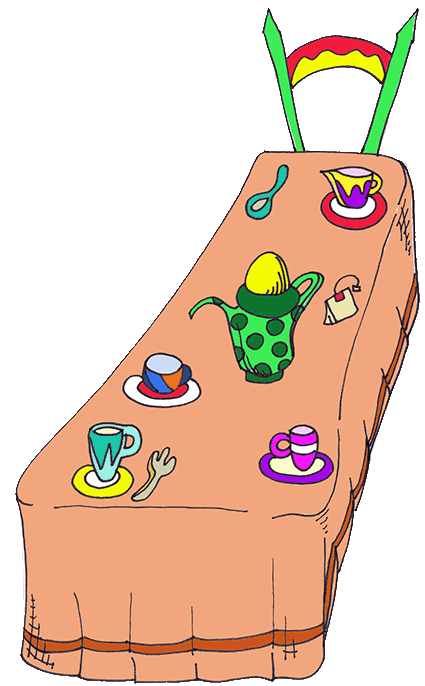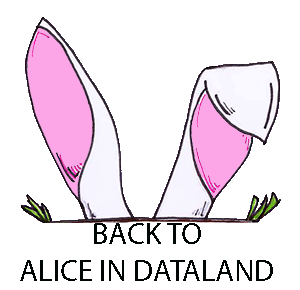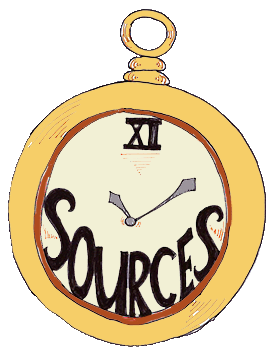
Alice had been looking over his shoulder with some curiosity. "What a funny watch!" she remarked. "It tells the day of the month, and doesn't tell what o'clock it is!"
"Why should it?" muttered the Hatter. "Does your watch tell you what year it is?"
"Of course not," Alice replied very readily, "but that's because it stays the same year for such a long time together."
"Which is just the case with mine," said the Hatter.
Alice felt dreadfully puzzled. The Hatter's remark seemed to have no sort of meaning in it, and yet it was certainly English.
In Tim Burton's film, Alice is first faced with distrust—do they have the "wrong Alice?" Has Alice grown up to accept the rules of society and thus lost the "muchness" that served her so well in her first trip to Wonderland? Lewis Carroll's Alice constantly tries to make sense of the world around her, and even, through her own recitations, is an active participant in nonsense-making. Alice subverts language, and meaning, across mediums.
The Mad Hatter's tea party is a grand moment of nonsense, with dialogue so dizzying that it is fitting that the party (as seen through the lens of Disney's cartoon) lives on as a ride. The party doesn't simply invert ritual: it takes social ritual to such extremes as to be absurd, drawing attention to the rules until they become almost incoherent. It is nonsense, but nonsense within structures.
Likewise the dialogue between Alice, the Mad Hatter, the Dormouse, and the March Hare subverts both language and the particular expectations of familiar childhood texts. It is here we probe at Alice's roots in the most logical of nonsense—
"They were learning to draw," the Dormouse went on, yawning and rubbing its eyes, for it was getting very sleepy; "and they drew all manner of things—everything that begins with an M—"
"Why with an M?" said Alice.
"Why not?" said the March Hare.
Why not, indeed? Such an apparently arbitrary choice draws to mind the practices of Oulipo, a group of writers known for operating under constraints and writing rules-based texts. Writers of lipograms omit (at least) a single letter from their novels as a fundamental constraint, thus changing the subset of language from which they create. Brian Kim Stefans groups Carroll's nonsense language among precursors not only of such non-digital texts but also of electronic and "ludic" literature. Ludic literature is informed by playfulness and takes the opportunity to use texts as the foundations of games.
The Mad Hatter plays with text quite deliberately in his reinterpretation of "Twinkle, Twinkle, Little Star:"
"Twinkle, twinkle, little bat!
How I wonder what you're at!"
"It goes on, you know," the Hatter continued, "in this way:—"
"Up above the world you fly,
Like a tea-tray in the sky.
Twinkle, twinkle—"
The Hatter remakes this iconic children's poem with enough deliberation to make the work both recognizable though perhaps, as Alice might say, with "no sort of meaning in it... and yet English." The image of the twinkling bat flying high as a tea-tray is evocative and yet difficult to visualize. Susanne Holthuis observed this lexical substitution as part of Wonderland's inherent intertextuality (131-132). The poem retold is Jane Taylor's "Twinkle, Twinkle, Little Star" (1806), which was cited by Nodelman and Reimer as an imitation of childhood written "only after it had become possible to believe that the innocence of childhood might represent greater wisdom than does adult reason" (26). The new poem follows the same rules, but diverges in metapor, calling to mind the accusations of "automatism" and "arbitrariness" that Alison James discusses as often leveled against writing under constraint (a procedural textural practice at work in Carroll's rhetoric as here in this webtext).
Where do we find Alice as we start to move into algorithmic space, from the lens of hypertext to the computer graphics landscapes of Wonderland? In this same spirit of nonsense—automated. In a provocation within Lewis Carroll's Bedside Book, compiled and extended by Edgar Cuthwellis, poetry is compared to music as awaiting "dilution" of the sort the Mad Hatter so knowledgebly constructs:
Why is it that Poetry has never yet been subjected to that process of Dilution which has proved so advantageous to her sister-art Music? The Diluter gives us first a few notes of some well-known air, then a dozen bars of his own, then a few more notes of the air, and so on alternately; thus saving the listener, if not from all risk of recognizing the melody at all, at least from the too-exciting transports which it might produce in a more concentrated form. (40)
The dilution of poetry is a natural practice in remix culture, where fragments of verse are passed around on Tumblr and quotes from forgotten sources are misattributed and recontextualized every day. Paul Levinson observes that the alphabet remains the "governing medium of cyberspace," though the construction of texts is changed and perhaps can make us more aware of the underlying rules in both logic and code (50). In that spirit, I've subjected the fragments of "Twinkle, Twinkle, Little Bat" to such a remix through automation and remaking Nick Montfort's Taroko Gorge.
The original Taroko Gorge is the type of playful procedural text that would be right at home at a mad tea party. Nick Montfort has chronicled the many "grabbings" of the work, which often begin with the same lexical substitution as the Mad Hatter employs—but into an algorithm, not a single verse. In his examination of electronic literature, Stuart Moulthrop notes how remixers (or re-makers) of Taroko Gorge are participants in citational poetics that I would argue are not unlike Carroll's own. A forum of remixers of Taroko Gorge convened at the 2012 Electronic Literature Organization Conference emphasized the "dynamic between appropriation and individuation" that comes from "common [algorithmic] DNA" (Klink et al.). Their experimentation further highlights what Lynda R. Stephenson observed in her "Road Trip" through cyberspace as literary space:
With printed text, the story or poem there is always an original that one can return to, a visceral first edition, however many new print runs or revised editions there may be. But what is the original of a hypertext work of art? In the world of the computer, the question makes little sense. There are no originals in cyberspace.
Thus, I have co-opted the poetics for Twinkle Bat, a revision of Nick Montfort's algorithm capable of generating the Hatter's original verse through the procedurality code affords Alice's structured nonsense. In these frameworks, questions of authorship naturally emerge: as Amaranth Borsuk asks, "Who is the author of the text-the coder? The source code? The source of the words?"
The same question could be applied to every mediation of Alice, and often the source is varied (Carroll's words? Tenniel's illustrations? Disney's animation?) and the resulting meaning distant. We might examine these textual allusions and inspirations through the model that Amaranth Borsuk advances as "data poetics:" "an exploration of the relationship between these two materials, words and numbers, as kinds of data around which meaning can be built, an index of information to be explored." It is through this lens (with images and motion alongside words and numbers) that Alice begins to come into focus as data.

